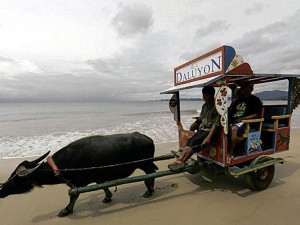
BEAST OF BURDEN. Carabaos, like these animals used to ferry tourists in Palawan, offer the country fresh hope for food sufficiency and the alleviation of poverty, according to the country’s dairy industry. EV ESPIRITU/INQUIRER NORTHERN LUZON
BAGUIO CITY—It’s time for carabao meat (carabeef) to get some respect in the domestic market, an agriculture official said during the recent Dairy Congress here.
Once described as an inferior quality product because only aged carabaos used to be slaughtered for meat, carabeef or water buffalo meat now tastes like prime beef due to improved processing technology, says Emelina Lopez, acting director of the Animal Products Development Center of the Bureau of Animal Industry (APDC-BAI).
Yet despite the upgrade, carabeef remains cheaper compared to beef, she says.
Beef sells for as high as P250 a kilogram but carabeef costs just P116 a kilo in local markets.
Lopez also cites a study conducted by the Philippine Carabao Center (PCC), which says that carabeef has 20.43 percent protein compared to beef, which has 19.02 percent. For the health conscious, Lopez says the fat content of carabeef is 2.87 percent, compared to the 4.34 percent fat content of beef.
At the 15th Dairy Congress here last week, officials of the Dairy Confederation of the Philippines (Dairycon) stressed the need for improving the population of dairy animals, like carabaos, as it pursues plans to increase Philippine-produced dairy products in a market that is dominated by imported milk.
Danilo Fausto, Dairycon chair, says the National Dairy Authority had taken “the bold step of targeting to infuse 60,000 head of dairy animals and the production of 55,000 genetically upgraded dairy cattle… up to the year 2016,” to increase homegrown supplies of fresh milk and meat.
The country’s carabao population is estimated at three million head, based on a March to April 2010 inventory of the Bureau of Agricultural Statistics (BAS).
But the supply is insufficient for the high demand of meat processing, which is why manufacturers still use imported buffalo meat from India, Lopez says.
Fausto says another problem is the lack of knowledge on how to properly feed dairy animals.
“Generally, cows and water buffaloes are underfed because farmers do not understand the required volume or nutritive value of various [animal] feed,” he says.
But in her presentation at the Dairy Congress, Lopez spoke of technologies that would improve farmers’ knowledge of their farm animals.
She says the PCC is pursuing genetic upgrading programs to harness the market potentials of carabeef and carabao milk, as well as byproducts like leather from carabao hide and handicraft from carabao bones, hooves and horns.
The PCC, in its website, says: “The Philippine carabao will continue to play a significant role in the country’s small hold farming system for many years to come, particularly in view of the dramatic decrease in the last couple of decades of land ownership above two hectares, and the corresponding increase in land ownership below one hectare.”
“This development is attributed to the continuous decline in land available for cultivation due to increases in urban usage, as against increases in relative number of people in the rural villages,” it adds.
Lopez says for carabeef to make a dent in the mainstream market, it will need to compete with imported products like hotdogs and European sausages, as well as local tocino (cured meat) and longganiza (native sausage).
To showcase the marketability of carabeef, APDC-BAI has produced pastrami, sausages, meatloaf, hotdog and sausages from meat of local carabaos.
It has also published a book which features recipes for carabeef, Lopez says. With a report from Vincent Cabreza, Inquirer Northern Luzon